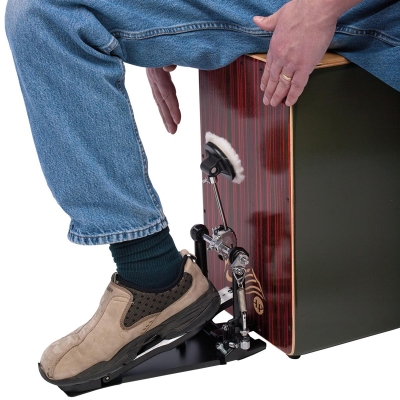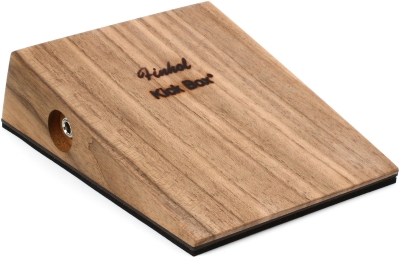
3) Alternate percussion, i.e., cajon, djembe, etc.
While this probably won’t work for a full-tilt rock band, it can be a great solution for worship and corporate gigs. A cajon is really fun to play, even for beginners, and is not very intimidating. In the hands of a skilled percussionist, it can be really great, plus it can be joined by additional enhancements such as a kick pedal or tambourine zils (those “jingle things”).
Miking cajon can be challenging on a loud stage, but this can be helped with the use of really cool double-mic pickups that include both a dynamic mic for the “boom” and a condenser mic for the “snap.”
Further, you can select the cajon style to match the style of music. I find that a “snare” cajon is the best choice for the genre of music I’m typically providing for smaller worship and corporate events.

A djembe can be a pretty serious percussion instrument in the right hands, but is still simple enough that most anyone can make some beats (think drum circle).
Add one to any of these other drum alternatives and it really makes the other musicians happy to play. At least that’s been my experience.
4) Smart drum pedals.
Set aside negative perceptions – some of the new drum pedals are a lot of fun to play while sounding great. Of course, it’s not like having a real drummer sitting behind you, but for smaller corporate and worship gigs they could be just what’s needed.
Here are a few examples that I’ve been experimenting with that interact with the front-line musicians and provide a lot of sonic options.
When Beat Buddy by Singular Sound first came out a few years ago, it was hard to take seriously. While the pedal sounded and worked great, and you could change parts of the song with the tap of a toe, there was no simple way to edit any of the drum programs, especially on a Mac computer.

And while the samples themselves sounded good, there wasn’t enough variety to make performers happy.
But all of that has changed and now there’s a really easy way to manage the drum loops on both Mac and PC, plus there’s now also an incredible library of songs and drum samples ready to play.
For $5 or so you get 10 drum programs ready to play along. There’s stuff from The Beatles, Eric Clapton, The Rolling Stones, Eagles, Pink Floyd and a lot more.
Plus you can assemble your own drum programs from the Beat Buddy online beat libraries that include all sorts of patterns. Further, new kits are being professionally recorded as samples that can be purchased for around $10, and there’s also a healthy online community of Beat Buddy users posting their own beats for free.
And for some real fun, there’s a “drunk drummer” setting that will slop up the beats in a controllable amount. It really is like a drummer in a box. (Sorry, drummers).

Yes, it’s a mouthful, but the Finhol Auto Stomp Laser Bundle is a very clever drum machine that can be driven manually by tapping your toe. It follows the user’s own playing tempo, not the other way around.
I’ve not had any actual drive time on one of these yet but saw a performer using it on stage a few weeks ago and it was really cool. By setting it to manual mode, the tapping of the toe is what sets the tempo for each measure. So the user can speed up and slow down the song and the drums follow, just as a real drummer would in a live situation. (It’s actually a little creepy.)

There are additional versions from Finhole available that just play a kick sample on a wooden wedge with a built-in trigger, which would make a nice addition to a cajon or djembe.
Is it as good as a real drummer on the back line? Of course not. But as a way to add interactive percussion to a semi-silent (or even fully-silent) Stage, these are useful pieces of technology.
The bottom line is don’t knock it until you’ve tried it. An 85 dB SPL stage with a 90 dB SPL room mix really is possible. But you just might have to convince your drummer first.
Click here for access to additional articles by Mike on development a semi-silent stage.
